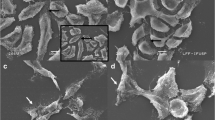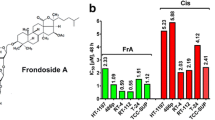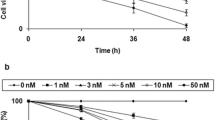ABSTRACT
Silibinin is a natural phenol found in the seeds of the milk thistle plant. Recent data have shown its effectiveness for preventing/treating bladder tumours. Therefore, in this study we investigated the cytotoxic and toxicogenetic activity of silibinin in bladder cancer cells with different TP53 statuses. Two bladder urothelial carcinoma cell lines were used: RT4 (wild-type TP53 gene) and T24 (mutated TP53 gene). Cell proliferation, clonogenic survival, apoptosis rates, genotoxicity and relative expression profile of FRAP/mTOR, FGFR3, AKT2 and DNMT1 genes and of miR100 and miR203 were evaluated. Silibinin promoted decreased proliferation and increased late apoptosis in TP53 mutated cells. Increased early apoptosis rates, primary DNA damage, and decrease of cell colonies in the clonogenic survival assay were detected in both RT4 and T24 cell lines. Down-regulation of FRAP/mTOR, AKT2, FGFR3, DNMT1 and miR100 expression occurred in RT4 cells. Modulation of miR203 was observed in both cell lines. In conclusion, despite the reduction of clone formation in both cell lines, the toxicogenomic effect of silibinin on FRAP/mTOR, AKT2, FGFR3, DNMT1 and miR100 was dependent on the TP53 status. Taken together, the data confirmed the role of silibinin as an antiproliferative compound, whose mechanism of action was related to the TP53 status.







Similar content being viewed by others
References
Ahmad A, Sakr WA and Rahman KMW 2012 Novel targets for detection of cancer and their modulation by chemopreventive natural compounds. Front. Biosci. Elite 4 410–425
Angeli JPF, Barcelos GRM, Serpeloni JM, Barbosa F, Nersesyan A and Mantovani MS 2010 Evaluation of the genotoxic and anti-genotoxic activities of silybin in human hepatoma cells (HepG2). Mutagenesis 25 223–229
Aravindaram K and Yang NS 2010 Anti-inflammatory plant natural products for cancer therapy. Planta Med. 76 1103–1117
Bartel DP 2004 MicroRNAs: genomics, biogenesis, mechanism, and function. Cell 116 281–297
Budanov AV and Karin M 2008 p53 target genes sestrin1 and sestrin2 connect genotoxic stress and mTOR signaling. Cell 134 451–460
Chawla RMP, Gupta D, Juneja M, Kumar R, Sharma A, Baliga MS, Sharma PK, Tripathi RP and Arora R 2010 Herbal medicine a cancer chemiopreventive and therapeutic perspective (Jaypee Brothers Medical Publishers)
Cheng L, Zhang S, MacLennan GT, Williamson SR, Lopez-Beltran A and Montironi R 2011 Bladder cancer: translating molecular genetic insights into clinical practice. Hum. Pathol. 42 455–481
Cui W, Gu F and Hu KQ 2009 Effects and mechanisms of silibinin on human hepatocellular carcinoma xenografts in nude mice. World J. Gastroenterol. 15 1943–1950
da Costa NM, Hautefeuille A, Cros MP, Melendez ME, Waters T, Swann P, Hainaut P and Pinto LF 2012 Transcriptional regulation of thymine DNA glycosylase (TDG) by the tumor suppressor protein p53. Cell Cycle 11 4570–4588
da Silva GN, Marcondes JPC, de Camargo EA, Passos Júnior G, Sakamoto-Hojo ET and Salvadori DMF 2010 Cell cycle arrest and apoptosis in TP53 subtypes of bladder carcinoma cell lines treated with cisplatin and gemcitabine. Exp. Biol. Med. 235 814–824
Dashzeveg N, Yogosawa S and Yoshida K 2016 Transcriptional induction of protein kinase C delta by p53 tumor suppressor in the apoptotic response to DNA damage. Cancer Lett. 374 167–174
Dobbin Z and Landen C 2013 The Importance of the PI3K/AKT/MTOR Pathway in the Progression of Ovarian Cancer. Int. J. Mol. Sci. 14 8213–8227
Dumont P, Ingrassia L, Rouzeau S and Ribaucour R 2007 The Amaryllidaceae isocarbostyril Narciclasine induces apoptosis by activation of the death receptor and/or mitochondrial pathways in câncer cells but not in normal fibroblasts. Neoplasia. 9 766–767
Esuvaranathan K, Chiong E, Thamboo TP, Chan YH, Kamaraj R and Mahendran R 2007 Predictive value of p53 and pRb expression in superficial bladder cancer patients treated with BCG and interferon-alpha. Cancer 109 1097–1105
Fang QL, Yin YR, Xie CR, Zhang S, Zhao WX and Pan C 2015 Mechanistic and biological significance of DNA methyltransferase 1 upregulated by growth factors in human hepatocellular carcinoma. Int. J. Oncol. 46 782–790
Garnett MJ, Edelman EJ, Heidorn SJ, Greenman CD, Dastur A, Lau KW, Greninger P, Thompson IR, et al. 2012 Systematic identification of genomic markers of drug sensitivity in cancer cells. Nature 483 570–575
Gingras AC, Raught B and Sonenberg N 2001 Regulation of translation initiation by FRAP/mTOR. Genes Dev. 15 807–826
Gohulkumar M, Gurushankar K, Rajendra Prasad N and Krishnakumar N 2014 Enhanced cytotoxicity and apoptosis-induced anticancer effect of silibinin-loaded nanoparticles in oral carcinoma (KB) cells. Mater. Sci. Eng. C. 41 274–282
Gong Y, He T, Yang L, Yang G, Chen Y and Zhang X 2015 The role of miRNA-100 in regulating apoptosis of breast cancer cells. Sci. Rep. 5 11650–11663
Gonzalez-Angulo AM and Blumenschein GR 2013 Defining biomarkers to predict sensitivity to PI3K/Akt/mTOR pathway inhibitors in breast cancer. Cancer Treat. Rev. 39 313–320
Guillermo-Lagae R, Deep G, Ting H, Agarwal C and Agarwal R 2015 Silibinin enhances the repair of ultraviolet B-induced DNA damage by activating p53-dependent nucleotide excision repair mechanism in human dermal fibroblasts. Oncotarget 6 39594–39606
Halberstein RA 2005 Medicinal plants: historical and cross-cultural usage patterns. Ann. Epidemiol. 15 686–699
Jemal A, Siegel R, Ward E, Murray T and Xu J 2007 Thun, Cancer statistics. CA Cancer J. Clin. 57 43–66
Kauntz H, Bousserouel S, Gossé F and Raul F 2013 Epigenetic effects of the natural flavonolignan silibinin on colon adenocarcinoma cells and their derived metastatic cells. Oncol. Lett. 5 1273–1277
Kaur M, Velmurugan B, Tyagi A, Deep G, Katiyar S and Agarwal C 2009 Silibinin suppresses growth and induces apoptotic death of human colorectal carcinoma LoVo cells in culture and tumor xenograft. Mol. Cancer Ther. 8 2366–2374
Knowles MA and Hurst CD 2014 Molecular biology of bladder cancer: new insights into pathogenesis and clinical diversity. Nature Rev. Cancer 15 25–41
Kumar S, Raina K, Agarwal C and Agarwal R 2014 Silibinin strongly inhibits the growth kinetics of colon cancer stem cell-enriched spheroids by modulating interleukin 4/6-mediated survival signals. OncoTarget 5 4972–4989
Leon IE, Porro V, Di Virgilio AL, Naso LG, Williams PAM and Bollati-Fogolín M 2014 Antiproliferative and apoptosis-inducing activity of an oxidovanadium(IV) complex with the flavonoid silibinin against osteosarcoma cells. J. Biol. Inorg. Chem. 19 59–74
Levine AJ and Oren 2009 The first 30 years of p53: growing ever more complex. Nat. Rev. Cancer 9 749–758
Li L, Gao Y, Zhang L, Zeng J, He D and Sun Y 2008 Silibinin inhibits cell growth and induces apoptosis by caspase activation, down-regulating survivin and blocking EGFR-ERK activation in renal cell carcinoma. Cancer Lett. 272 61–69
Li DW, Sun JY, Wang K, Zhang S, Hou YJ and Yang MF 2015 Attenuation of cisplatin-induced neurotoxicity by cyanidin, a natural inhibitor of ROS-mediated apoptosis in PC12 cells. Cell Mol. Neurobiol. 35 995–1001
Livak KJ and Schmittgen TD 2001 Analysis of relative gene expression data using real-time quantitative PCR and the 2(-Delta Delta C(T)) Method. Methods 25 402–408
Luo J, Manning BD and Cantley LC 2003 Targeting the PI3K-Akt pathway in human cancer: rationale and promise. Cancer Cell 4 257–262
Maiti A and Drohat AC 2011 Thymine DNA glycosylase can rapidly excise 5-formylcytosine and 5-carboxylcytosine: potential implications for active demethylation of CpG sites. J. Biol. Chem. 286 35334–35338
Mateen S, Raina K, Agarwal C, Chan D and Agarwal R 2013 Silibinin synergizes with histone deacetylase and DNA methyltransferase inhibitors in upregulating E-cadherin expression together with inhibition of migration and invasion of human non-small cell lung cancer cells. J. Pharmacol. Exp. Ther. 345 206–214
Mayr R, Fritsche HM, Pycha A and Pycha A 2014 Radical cystectomy and the implications of comorbidity. Expert. Rev. Anticancer Ther. 14 289–295
Moseley VR, Morris J, Knackstedt RW and Wargovich MJ 2013 Green tea polyphenol epigallocatechin 3-gallate, contributes to the degradation of DNMT3A and HDAC3 in HCT 116 human colon cancer cells. Anticancer Res. 33 5325–5333
Nagaraja AK, Creighton CJ, Yu Z, Zhu H, Gunaratne PH and Reid JG 2010 A link between mir-100 and FRAP1/mTOR in clear cell ovarian cancer. Mol. Endocrinol. 24 447–463
Patel SG, Cohen A, Weiner AB and Steinberg GD 2015 Intravesical therapy for bladder cancer. Expert. Opin. Pharmacother. 16 889–901
Philippou Y, Hadjipavlou M, Khan S and Rane A 2013 Complementary and alternative medicine (CAM) in prostate and bladder cancer. BJU Int. 112 1073–1079
Raghavan D, Burgess E, Gaston KE, Haake MR and Riggs SB 2012 Neoadjuvant and adjuvant chemotherapy approaches for invasive bladder cancer. Semin. Oncol. 39 588–597
Raina K, Agarwal C and Agarwal R 2013 Effect of silibinin in human colorectal cancer cells: targeting the activation of NF-κB signaling. Mol. Carcinog. 52 195–206
Rajamanickam S, Velmurugan B, Kaur M, Singh RP and Agarwal R 2010 Chemoprevention of intestinal tumorigenesis in APCmin/+ mice by silibinin. Cancer Res. 70 2368–2378
Retz M, Schmid SC, Kramer MW and Merseburger AS 2013 Systemische Therapie des metastasierten Blasenkarzinoms. Urology 52 1541–1546
Rihani A, Van Goethem A, Ongenaert M, De Brouwer S, Volders PJ, Agarwal S, De Preter K, Mestdagh P, et al. 2015 Genome wide expression profiling of p53 regulated miRNAs in neuroblastoma. Sci. Rep. 5. doi:10.1038/srep09027
Saini S, Arora S, Majid S, Shahryari V, Chen Y and Deng G 2011 Curcumin modulates microRNA-203-mediated regulation of the Src-Akt axis in bladder cancer. Cancer Prev. Res. 4 1698–1709
Saint F, Le Frere Belda MA, Quintela R, Hoznek A, Patard JJ and Bellot J 2004 Pretreatment p53 nuclear overexpression as a prognostic marker in superficial bladder cancer treated with Bacillus Calmette-Guérin (BCG). Eur. Urol. 45 475–482
Sávio ALV, da Silva GN and Salvadori DMF 2015 Inhibition of bladder cancer cell proliferation by allyl isothiocyanate (mustard essential oil). Mutat. Res. 771 29–35
Shaw RJ and Cantley LC 2006 Ras PI(3)K and mTOR signalling controls tumour cell growth. Nature 441 424–430
Singh NP, McCoy MT, Tice RR and Schneider EL 1988 A simple technique for quantitation of low levels of DNA damage in individual cells. Exp. Cell Res. 175 184–197
Sinha S, Jothiramajayam M, Ghosh M, Jana A, Chatterji U and Mukherjee A 2015 2015 Vetiver oil (Java) attenuates cisplatin-induced oxidative stress, nephrotoxicity and myelosuppression in Swiss albino mice. Food Chem. Toxicol. 81 120–128
Suzuki HI, Yamagata K and Sugimoto K 2009 Modulation of microRNA processing by p53. Nature 460 529–533
Tannock IF, Lee C 2001 Evidence against apoptosis as a major mechanism for reproductive cell death following treatment of cell lines with anti-cancer drugs. Br. J. Cancer 84 100–105
Tice RR, Andrews PW, Hirai O and Singh NP 1991 The single cell gel (SCG) assay: an electrophoretic technique for the detection of DNA damage in individual cells. Adv. Exp. Med. Biol. 283 157–164
Ting H, Deep G and Agarwal R 2013 Molecular mechanisms of silibinin-mediated cancer chemoprevention with major emphasis on prostate cancer. AAPS J. 15 707–716
Tyagi A, Agarwal C, Harrison G, Glode LM and Agarwal R 2004 Silibinin causes cell cycle arrest and apoptosis in human bladder transitional cell carcinoma cells by regulating CDKI-CDK-cyclin cascade, and caspase 3 and PARP cleavages. Carcinogenesis 25 1711–1720
Tyagi A, Raina K, Singh RP, Gu M, Agarwal C and Harrison G 2007 Chemopreventive effects of silymarin and silibinin on N-butyl-N-(4-hydroxybutyl) nitrosamine induced urinary bladder carcinogenesis in male ICR mice. Mol. Cancer Ther. 6 3248–3255
van Lingen AV, Arends TJH and Witjes JA 2013 Expert review: an update in current and developing intravesical therapies for non-muscle-invasive bladder cancer. Expert. Rev. Anticancer. Ther. 13 1257–1268
Vinall RL, Ripoll AZ, Wang S, Pan CX and deVere WRW 2012 MiR-34a chemosensitizes bladder cancer cells to cisplatin treatment regardless of p53-Rb pathway status. Int. J. Cancer. 130 2526–2538
Wang G, Chen L, Meng J, Chen M, Zhuang L and Zhang L 2013 Overexpression o f miRNA-100 predicts an unfavorable prognosis in renal cell carcinoma. Int. Urol. Nephrol. 45 373–379
Weng JR, Lai IL, Yang HC, Lin CN and Bai LC 2014 Identification of kazinol Q, a natural product from Formosan plants, as an inhibitor of DNA methyltransferase. Phytother. Res. 28 49–54
Wu L and Belasco JG 2008 Let me count the ways: mechanisms of gene regulation by miRNAs and siRNAs. Mol. Cell 2 1–7
Yoo HG, Jung SN, Hwang YS, Park JS, Kim MH and Jeong M 2004 Involvement of NF-kappaB and caspases in silibinin-induced apoptosis of endothelial cells. Int. J. Mol. Med. 13 81–86
Yousefi M, Ghaffari SH, Soltani BM, Nafissi S, Momeny M, Zekri A, Behmanesh M, Alimoghaddam K, et al. 2012 Therapeutic efficacy of silibinin on human neuroblastoma cells: Akt and NF-κB expressions may play an important role in silibinin-induced response. Neurochem. Res. 37 2053–2063
Zeng J, Sun Y, Wu K, Li L, Zhang G and Yang Z 2011 Chemopreventive and chemotherapeutic effects of intravesical silibinin against bladder cancer by acting on mitochondria. Mol. Cancer Ther. 10 104–116
Zhang Y, Yan L, Zhao Y, Ou L, Wu X and Luo C 2013 Knockdown of Phospholipase C-epsilon by short-hairpin RNA-mediated gene silencing induces apoptosis in human bladder cancer cell lines. Cancer Biother. Radiopharm. 28 233–239
Zwergel C, Valente S and Mai A 2016 DNA methyltransferases inhibitors from natural sources. Curr. Top. Med. Chem. 16 680–696
Acknowledgements
This study was supported by Fundação de Amparo à Pesquisa do Estado de São Paulo (FAPESP-2008/09147-6), Fundação de Amparo à Pesquisa do Estado de Minas Gerais (CBB-APQ-01497-14), Conselho Nacional de Desenvolvimento Científico e Tecnológico (CNPq-441836/2014-3) and Universidade Federal de Ouro Preto (UFOP).
Author information
Authors and Affiliations
Corresponding author
Additional information
[de Oliveira DT, Sávio ALV, de Castro Marcondes JP, Barros TM, Barbosa LC, Salvadori DMF and da Silva GN 2017 Cytotoxic and toxicogenomic effects of silibinin in bladder cancer cells with different TP53 status. J. Biosci.]
Daiane Teixeira de Oliveira and André Luiz Ventura Sávio contributed equally to this work.
Rights and permissions
About this article
Cite this article
de Oliveira, D.T., Sávio, A.L.V., de Castro Marcondes, J.P. et al. Cytotoxic and toxicogenomic effects of silibinin in bladder cancer cells with different TP53 status. J Biosci 42, 91–101 (2017). https://doi.org/10.1007/s12038-016-9654-5
Received:
Accepted:
Published:
Issue Date:
DOI: https://doi.org/10.1007/s12038-016-9654-5




